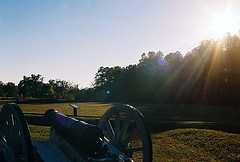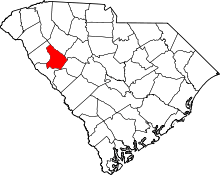Ninety Six, South Carolina
| Ninety Six, South Carolina | |
|---|---|
| Town | |
|
Sunset over the battlefield at Star Fort | |
|
Location of Ninety Six, South Carolina | |
| Coordinates: 34°10′24″N 82°1′18″W / 34.17333°N 82.02167°WCoordinates: 34°10′24″N 82°1′18″W / 34.17333°N 82.02167°W | |
| Country | United States |
| State | South Carolina |
| County | Greenwood |
| Area | |
| • Total | 1.5 sq mi (3.8 km2) |
| • Land | 1.5 sq mi (3.8 km2) |
| • Water | 0.0 sq mi (0.0 km2) |
| Elevation | 548 ft (167 m) |
| Population (2000) | |
| • Total | 1,936 |
| • Density | 1,325.1/sq mi (511.6/km2) |
| Time zone | Eastern (EST) (UTC-5) |
| • Summer (DST) | EDT (UTC-4) |
| ZIP code | 29666 |
| Area code(s) | 864 |
| FIPS code | 45-50290[1] |
| GNIS feature ID | 1249874[2] |
| Website | www.townofninetysixsc.com |
Ninety Six is a town in Greenwood County, South Carolina, United States. The population was 1,998 at the 2010 census.
Geography
Ninety Six is located at 34°10′24″N 82°1′18″W / 34.17333°N 82.02167°W (34.173211, -82.021710).[3]
According to the United States Census Bureau, the town has a total area of 1.5 square miles (3.8 km²), all land.
Etymology
There is much confusion about the mysterious name, "Ninety-Six," and the true origin may never be known. Some believe Sam Crittendon once ran 96 miles to play a round of golf when it was raining in Ninety-Six (sic), and so named it Ninety-Six for the distance he had to travel in order to play. Speculation has led to a romantic Indian myth; to the mistaken belief that it was 96 miles to the nearest Cherokee settlement of Keowee; to a counting of creeks crossing the main road leading from Lexington, SC, to Ninety-Six, SC; to an interpretation of a Welsh expression, "nant-sych," meaning "dry gulch." However, no one is able to confirm that Robert Goudey (sic) was Welsh, English, Scottish, or German. An examination of early maps indicates markings such as "30" and "60" and "90" at different points, possibly indicating "chains." Since Ninety-Six was located in Clarendon Parish, it is possible that Parish linear measurements used in England were used on colonial maps to measure distances in "chains". In England, according to a British and Welsh booklet designating linear measurements, Parish maps used a rule of "4 chains to the inch." In using that parish rule on an early map of colonial South Carolina, 90 "chains" on a map would probably cover approximately 24 inches, the map distance from "Saxe Gotha" (modern Lexington, SC) to Ninety-Six. Using the same measurements for the distance from Ninety-Six to the Savannah River, the measurement would be approximately 2.5 inches or 6 "chains," hence 96. Even so, the origin of the name, "Ninety-Six," likely remains a mystery.[4]
History
Ninety Six was established on the frontier in the early 18th century; it was known for a time as "Jews Land" because some prominent Sephardic Jewish families of London bought extensive property there. The Salvador and DaCosta families bought 200,000 acres (810 km2), intending to help some poor Sephardic families to relocate to the New World.[5]
The settlement became the capital city of the Ninety-Six District when it was established in July 1769. Since the late 20th century, the National Park Service operates the Ninety Six National Historic Site at the site of the original settlement and fort.
Ninety Six figured prominently in the Anglo-Cherokee War (1758-1761). It also was a site for southern campaigns of the American Revolutionary War. The first land battle of the revolution south of New England was fought here in 1775. On August 1, 1776, American militia forces led by Major Andrew Williamson were ambushed by Cherokee and Loyalists near here in the Battle of Twelve Mile Creek; more than 4,000 Cherokee had waged war on a long front beginning in June, from Tennessee to central South Carolina.[6] Francis Salvador, a Sephardic Jewish immigrant from London and a planter, was one of the casualties, the first Jew to be killed fighting with the Patriots in the Revolutionary War.[7]
In 1780 the British fortified the strategically important frontier town with a star fort. From May 22 to June 18, 1781 Major General Nathanael Greene, with 1,000 American Patriot troops, besieged 550 American Loyalists who were defending Ninety Six. General Greene's chief engineer at the siege was the world-renowned Polish hero Colonel Tadeusz Kościuszko, who was wounded at the siege. The American Loyalists survived the siege and relocated after the war to Rawdon, Nova Scotia, Canada, with support from the Crown for resettlement.
The Kinard House, Moore-Kinard House, Ninety Six National Historic Site, and Southern Railway Depot (Ninety Six, South Carolina) are listed on the National Register of Historic Places.[8][9]
Demographics
As of the census[1] of 2000, there were 1,936 people, 820 households, and 560 families residing in the city. The population density was 1,325.1 people per square mile (512.0/km²). There were 904 housing units at an average density of 618.7 per square mile (239.1/km²). The racial makeup of the town was 76.50% White, 22.73% Black, 0.15% Native American, 0.05% Asian, 0.21% from other races, and 0.36% from two or more races. Hispanic or Latino of any race were 0.52% of the population.
There were 820 households out of which 30.1% had children under the age of 18 living with them, 47.1% were married couples living together, 17.6% had a female householder with no husband present, and 31.6% were non-families. 29.3% of all households were made up of individuals and 16.0% had someone living alone who was 65 years of age or older. The average household size was 2.36 and the average family size was 2.90.
In the town the population was spread out with 24.9% under the age of 18, 7.4% from 18 to 24, 27.7% from 25 to 44, 22.9% from 45 to 64, and 17.1% who were 65 years of age or older. The median age was 38 years. For every 100 females there were 81.1 males. For every 100 females age 18 and over, there were 78.0 males.
The median income for a household in the town was $33,423, and the median income for a family was $39,550. Males had a median income of $30,978 versus $25,034 for females. The per capita income for the town was $15,648. About 7.0% of families and 8.3% of the population were below the poverty line, including 8.6% of those under age 18 and 8.7% of those age 65 or over.
Notable people
- Congressman Preston Brooks, (who was born in Roseland, Edgefield County, South Carolina), attacked Massachusetts abolitionist senator, Charles Sumner, with a cane in the Senate Chamber in 1856.
- Orville Vernon Burton, Professor of History and Sociology at the University of Illinois at Champaign-Urbana, was raised in Ninety Six. His book, In My Father’s House Are Many Mansions: Family and Community in Edgefield, South Carolina traces the social history of that region.
- Benjamin Mays, sixth president of Morehouse College and mentor to Martin Luther King, Jr.; was born in the vicinity of Ninety Six.
- Odean Pope, (1938–present), jazz tenor saxophonist, was born in Ninety Six, but grew up in Philadelphia, Pennsylvania.[10]
- Francis Salvador (1747-1776), bought land in Ninety-Six District, and was the first Jew to be elected to public office in the colonies (1774, to SC's Provincial Congress) as well as the first Jew killed in the American Revolution
- Bill Voiselle, pitcher for the New York Giants, Boston Braves, and Chicago Cubs, wore his hometown as uniform number "96" when playing with Boston and Chicago.
Davy Hite, professional bass fisherman and champion of the 1999 Bassmaster Classic, lives in Ninety Six.
Representation in popular culture
- The 1781 siege was described in William Gilmore Simms' novel, The Forayers, (1855).
- It is also featured in Kenneth Roberts' novel, Oliver Wiswell (1940), which includes a chapter entitled, "Ninety-Six."
References
- ↑ 1.0 1.1 "American FactFinder". United States Census Bureau. Retrieved 2008-01-31.
- ↑ "US Board on Geographic Names". United States Geological Survey. 2007-10-25. Retrieved 2008-01-31.
- ↑ "US Gazetteer files: 2010, 2000, and 1990". United States Census Bureau. 2011-02-12. Retrieved 2011-04-23.
- ↑ Guinn, Dr. Gilbert; Geraldine Beach & Rose Mitchell (2004). Maps for Family and Local History (2nd revised edition ed.). Tonawanda, New York: Dundurn Press. p. 35.
- ↑ Pencak, William (2005). Jews and Gentiles in Early America 1654–1800, Ann Arbor: University of Michigan Press, p. 124
- ↑ LLEWELLYN M. TOULMIN, "Backcountry Warrior: Brig. Gen. Andrew Williamson", Journal of Backcountry Studies, Vol. 7 No.1, Spring 2012
- ↑ Nell Porter Brown, "A 'portion of the People'", Harvard Magazine, January–February 2003
- ↑ "National Register Information System". National Register of Historic Places. National Park Service. 2010-07-09.
- ↑ "National Register of Historic Places Listings". Weekly List of Actions Taken on Properties: 10/03/11 through 10/07/11. National Park Service. 2011-11-14.
- ↑ Odean Pope website
Further reading
- Carol W. Troxler, "Scotch-Irish among Southern Backcountry Loyalists,” Journal of Scotch-Irish Studies, I no. 3 (October 2002).
External links
| |||||||||||||||||||||||||||||

